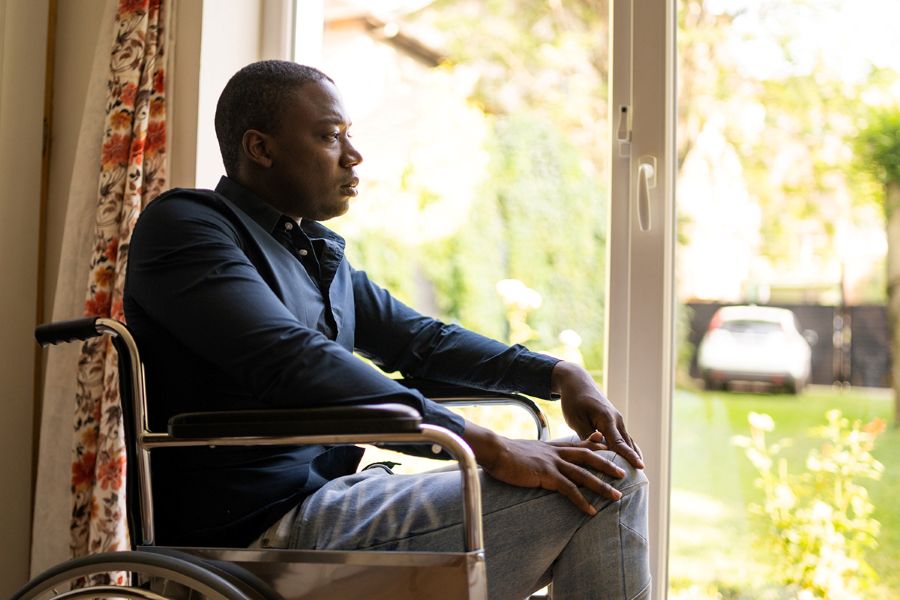
Psychological sequalae from spinal cord injury are broad and influence multiple areas of an individual’s life. Depending on the level of neurologic injury and associated prognosis, a person’s sensation, movement and autonomic functioning are changed, sometimes indefinitely.
In data collected since 2015, more than 18,000 new traumatic spinal cord injuries occur yearly in the United States, with 25% of those injured being Black-not Hispanic or Latino at an average age of 44 years and the majority being male (National Spinal Cord Injury Statistical Center, 2024); at this age such an injury impacts employability and family responsibilities. Research has shown that alcohol and drug use at the time of injury was more prominent in this population compared to the general population, with up to 50% using alcohol, up to 33% using drugs, and around 25% using a combination of substances (Tetrault & Courtois 2014). Since this is a chronic condition, rehospitalization within a year of new injury occurs in about 36% of those with traumatic injuries, often for urogenital, respiratory and skin-related conditions (DeJong et al., 2013).
The adjustment process is dynamic, and the type of coping skill utilized depends on the individual’s setting (acute versus rehabilitation, Wegener et al. 2012). Use of evidence-based coping strategies (cognitive and behavioral) is preferred, though learning and retrieval of these skills can be impacted by co-occurring traumatic brain injury (Macciocchi, et al. 2008). Many individuals are resilient after injury and the rates of depression, anxiety and post-truamatic stress disorder range from about 10%-30% (Poritz et al., 2018, Le & Dorstyn, 2016, Cao et al. 2017). Finding support, through individual and group therapies, can assist the individual in the adjustment process. Unhealthy coping skills, such as use of substances, are greater in the spinal cord injury population compared to that of the general population (Kolakowsky-Hayner et al. 2002).
Pain after spinal cord injury is complex, person-centric, and influenced by medical issues, injury site and psychological factors such as coping strategies and emotional distress (Widerström-Noga, 2023). Pain is categorized into nocioceptive (musculoskeletal, visceral) or neuropathic (nerve damage) pain and is experienced by an estimated 65% of individuals with spinal cord injury (Siddal & Loeser, 2001). Psychological treatments such as cognitive behavioral therapy, mindfulness and acceptance and commitment therapy are available and effective besides the pharmacologic or procedural interventions (Eller et al., 2022, Waldron-Perrine et al. 2022).
Family members are also impacted by a spinal cord injury in different ways. The familial roles and responsibilities change dramatically if the individual with an injury is no longer able to manage their activities of daily living or assist with meals, housekeeping and other household duties. Family caregivers for those with spinal cord injury expressed increased stress in family functioning and communication (Jeyathevan et al., 2019). Caregivers were found to have lower quality of life, increased sense of burden and poorer physical health and while studies of caregiver needs were few, increased social support, education and therapy targeting problem-solving abilities were helpful (Wilson et al., 2022).
While the physiological aspect of sexual dysfunction after spinal cord injury is often the focus of discussion, the psychological piece of the construct of sexuality and intimacy is also important. As summarized by Earle et al. (2020), regaining sexual functioning is a vital part of quality of life after injury and is impacted by changes in body image, decreased desire, and lack of a partner in addition to the physiological changes. These authors added that sexuality after spinal cord injury is often under-research, stigmatized and impacted by cultural and gender expectations. They underscored the need for education and intervention by rehabilitation professionals.
Gainful employment is a source of increased quality of life, pride and socialization for many individuals. Returning to work after spinal cord injury is often one of the main objectives of the individual though barriers exist in meeting this goal. Specifically, Ottomanelli and Lind (2009) reported that 35% of those with injuries return to work. In a review of the literature, Anderson et al. (2007) reported multiple factors associated with returning to work including the severity of injury and time since injury, education level, marital and social support, employer’s attitudes and environment among others. Some individuals are unable to return to the exact type of preinjury work and government support/compensation can also impact an individual’s incentive to work. This underscores the individual and systematic forces that a person with an injury must navigate post-injury.
In summary, spinal cord injury is a life-changing event that impacts physical, psychological and psychosocial areas of those with the injury, their families and caregivers. Stress burden impacts familial relationships, coping skills and quality of life. Adjustment, pain, substance abuse, sexuality and vocational entry are common topics in the rehabilitation literature of spinal cord injury and are areas of intervention for psychologists and other care professionals.
Learn more about Northside Hospital Rehabilitation Services.
References:
- Anderson, D., Dumont, S., Azzaria, L., Bourdais, M.L., & Noreau, L. (2007). Determinants of return to work among spinal cord injury patients: A literature review. Journal of Vocational Rehabilitation, 27(1):57-68. doi: 10.3233/JVR-2007-00385.
- Cao, Y., Li, C., Newman, S., Lucas, J., Charlifue, S., & Krause, J. S. (2017). Posttraumatic stress disorder after spinal cord injury. Rehabilitation psychology, 62(2), 178–185. https://doi.org/10.1037/rep0000135.
- DeJong, G., Tian, W., Hsieh, C., Junn, C., Karam, C., Ballard, P.H., Smout, R.J., Horn, S.D., Zanca, J.M., Heinemann, A.W., Hammond, F.M., Backus, D. (2013). Rehospitalization in the first year of traumatic spinal cord injury after discharge from medical rehabilitation. Archives of Physical Medicine and Rehabilitation, 94(4), 587-597. https://doi.org/10.1016/j.apmr.2012.10.037.
- Kolakowsky-Hayner, S.A., Courgley, E.V., Kreutzer, J.S., Marwitz, J.H., Meade, M.A., & Cifu, D.X. (2002). Post-injury substance abuse among persons with brain injury and persons with spinal cord injury. Brain Injury, 16(7), 583-592. https://doi.org/10.1080/02699050110119475.
- Le, J., Dorstyn, D. (2016). Anxiety prevalence following spinal cord injury: a meta-analysis. Spinal Cord 54, 570–578. https://doi.org/10.1038/sc.2016.15.
- Macciocchi, S., Seel, R. T., Thompson, N., Byams, R., & Bowman, B. (2008). Spinal cord injury and co-occurring traumatic brain injury: assessment and incidence. Archives of physical medicine and rehabilitation, 89(7), 1350–1357. https://doi.org/10.1016/j.apmr.2007.11.055.
- National Spinal Cord Injury Statistical Center. (2025). Traumatic Spinal Cord Injury Facts and Figures at a Glance. Birmingham AL: University of Alabama at Birmingham, 2024. https://msktc.org/sites/default/files/Facts-and-Figures-2024-Eng-508.pdf.
- Ottomanelli, L., & Lind, L. (2009). Review of critical factors related to employment after spinal cord injury: implications for research and vocational services. The journal of spinal cord medicine, 32(5), 503–531. https://doi.org/10.1080/10790268.2009.11754553.
- Poritz, J. M. P., Mignogna, J., Christie, A. J., Holmes, S. A., & Ames, H. (2018). The Patient Health Questionnaire depression screener in spinal cord injury. The journal of spinal cord medicine, 41(2), 238–244. https://doi.org/10.1080/10790268.2017.1294301.
- Tetrault, M., & Courtois, F. (2014). Use of psychoactive substance sin persons with spinal cord injury: A literature review. Annals of Physical and Rehabilitation Medicine 57(9-10), 684-695. http://dx.doi.org/10.1016/j.rehab.2014.10.002.
- Waldron-Perrine, B., Kisser, J., Robinett, E., Hanks, R. A., & Kratz, A. (2022). Association between Acceptance and Commitment Therapy (ACT) processes and depressive symptoms and pain interference in persons with spinal cord injury (SCI). Rehabilitation Psychology, 67(4), 602–609. https://doi.org/10.1037/rep0000466.
- Wegener, S.T., Adams, L.L., & Rohe, D. (2012). Promoting optimal functioning in spinal cord injury: the role of rehabilitation psychology. In J. Verhaagen & J.M. McDonald III (Eds.), Handbook of Clinical Neurology (3rd series, pp. 297-314). Elsevier B.V.
- Wilson, C.S., DeDios-Stern, S., Bocage, C., Gray, A.A., Crudup, B.M., & Russell, H.F. (2022). A systematic review of how spinal injury impacts families. Rehabilitation Psychology, 67(3), 273-303. https://dio.org/10.1037/rep0000431.

